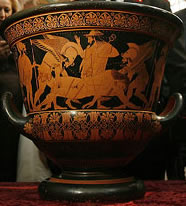 Sydney’s city hall was built on a cemetery, so apparently every time they need to do some renovation work they end up excavating the remains of convicts. The last coffin/headstone type graves were moved in the 1880s, but convicts weren’t so formally buried, so their remains may have shifted.
Sydney’s city hall was built on a cemetery, so apparently every time they need to do some renovation work they end up excavating the remains of convicts. The last coffin/headstone type graves were moved in the 1880s, but convicts weren’t so formally buried, so their remains may have shifted.
This time around officials issued a public invitation to visit the site while it’s being excavated, and the response was enthusiastic, to say the least.
[M]ore than 2,000 people, many of them office workers on their lunch break, were estimated to have joined the queue which stretched around the building in the heart of the bustling modern city. [..]
Once inside, the crowds watched archaeologists at work in a shallow pit under the Peace Hall as they try to find any last shards of bone in the moist clay of the 53 graves of adults and children unearthed last year.
I think it’s neat that they allowed public viewing of the grave site, and even neater that so many people showed up. I know I would have.
 The auctioneers thought it was a 19th c. French claret jug with an estimated value of a couple hundred pounds. Turns out, it’s an
The auctioneers thought it was a 19th c. French claret jug with an estimated value of a couple hundred pounds. Turns out, it’s an 
